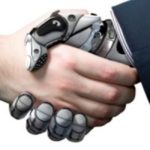Are robots a threat to jobs?
This question, which has been asked about machines since the age of industrialization and the appearance of assembly lines, was in the headlines again at the latest Davos World Economic Forum. With robot sales growing steadily over the last three years, 2015 was a record year, exceeding 2014 sales by 15%, according to the International Federation of Robotics (IFR)

Around 229,000 robots are sold a year and Bank of America Merrill Lynch estimates that by 2025 they will perform 45% of industrial manufacturing tasks, compared to the current 10%. These figures show the growing use of robotics, which seems to be ready to move from factories to new production spaces such as health, transportation, homes, military defense or the aerospace sector.
These prospects have aroused old fears, which until now were more in the realm of science fiction, but which seem to become a reality in the eyes of the World Economic Forum. Robotics and artificial intelligence have become catalysts for the famous fourth industrial revolution, but with very clear consequences for jobs.
The report Future of Jobs by the World Economic Forum says that these new trends (which in addition to robotics include artificial intelligence, machine learning, nanotechnology, 3D printing, genetics and biotechnology) could have an impact on 5.1 million jobs from 2015 to 2020.
Despite this forecast, many believe that new technology generates wealth and employment in the long term, particularly among the sectors and professions that make intensive use of technology, as James Bessen, Professor of Boston University, claims in this ebook by the BBVA Innovation Center. Also, a recent article by McKinsey maintains that only 5% of jobs can be performed entirely by a robot.
Computing, mathematics and engineering will lead the creation of employment
However, the report by the World Economic Forum maintains that a total of 7.1 million jobs will disappear, two-thirds of them concentrated in office and administrative jobs, and two million new jobs will be created in fields related to computing, mathematics, architecture and engineering.
The jobs related to manufacturing and production will also be particularly affected by these technologies, but according to the report they can be updated through new technological knowledge to retrain in the new production chains.
New profiles
The new profiles most demanded include data analysts, which are key to making sense of the huge amounts of data that will have to be handled by corporations, and highly specialized sales reps capable of explaining the new offerings and services to companies, governments and customers. This new commercial profile, whose demand is detected in all industries and geographical areas, is explained by the need to understand better, highly innovative and disruptive products and/or because corporations will target audiences they are not familiar with.
Another professional profile detected particularly in the energy sector, the media, entertainment and information is a new type of senior executive to successfully guide companies through these disruptive changes.